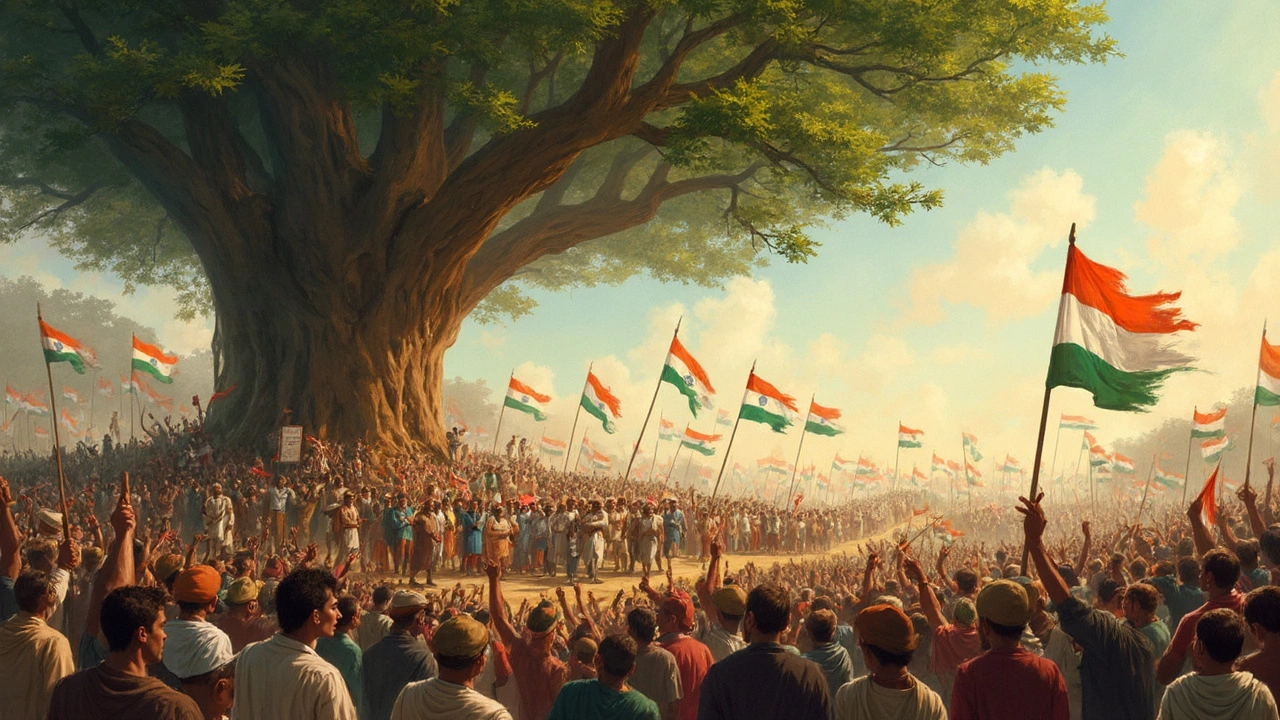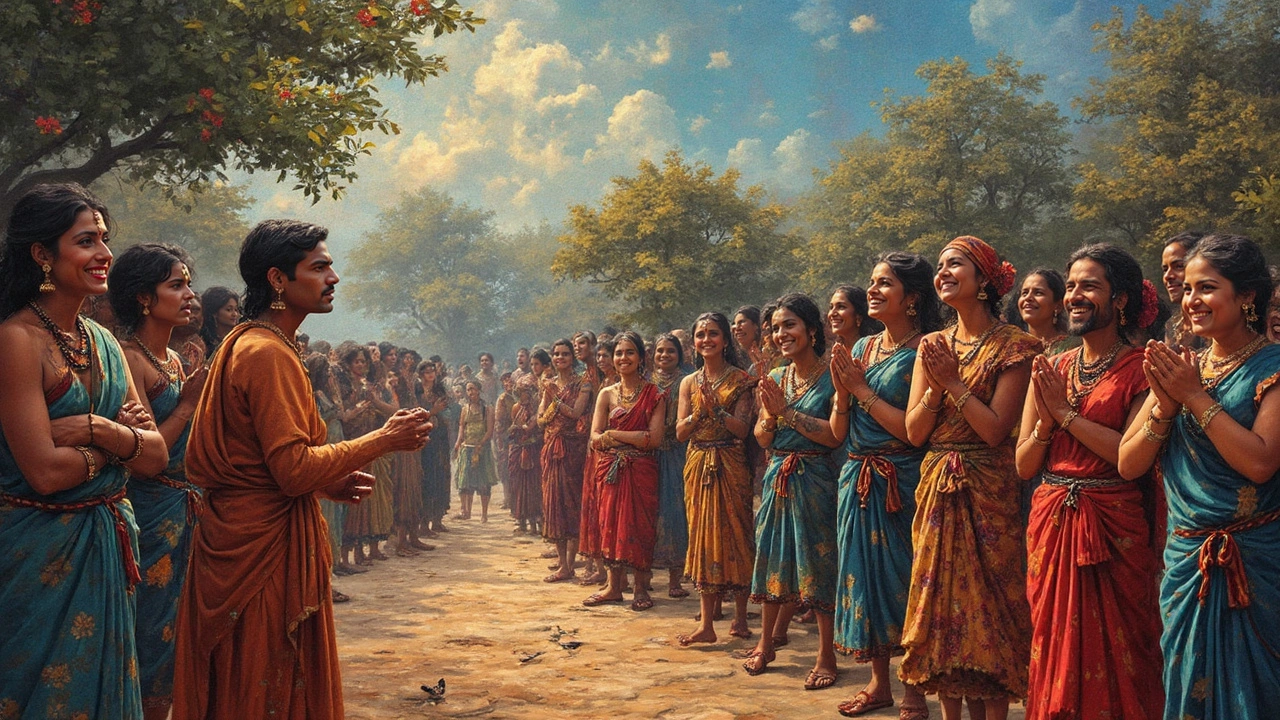Patriotic Poems Celebrating India

When it comes to patriotic poetry in India, one poem stands out as a beacon of national pride and unity – "Vande Mataram." Created by the renowned writer Bankim Chandra Chattopadhyay, this poem has become synonymous with India's struggle for independence. So, what makes it so special?
Written during the British colonial rule in the late 19th century, "Vande Mataram" captures the essence of India's rich culture and the deep love for the homeland. It serves as a reminder of the collective struggle for freedom and independence from colonial rule.
But beyond just history, the poem's vivid imagery and compelling themes speak volumes. It paints a picture of India's natural beauty and the sacrifices made by countless freedom fighters. The use of metaphors and rhythmic verses make it not just a poem but an anthem that resonates in every Indian heart.
The Iconic Patriotic Poem
"Vande Mataram" isn't just a poem; it's an emblem of India's spirit of freedom and unity. Penned by Bankim Chandra Chattopadhyay in Sanskrit, it first appeared in his 1882 novel 'Anandamath'. What makes this poem iconic is its dual role as both art and anthem, rousing feelings of patriotism across generations.
The Birth of a Legend
Composed during a time when India was under British rule, "Vande Mataram" emerged as a powerful symbol of resistance. Its literal meaning, "I praise thee, Mother", reveres the motherland as divine. The poem was written at a time when expressing nationalistic sentiments openly was risky, yet Bankim's words encouraged people to visualize an India united in its quest for freedom.
The Structure of "Vande Mataram"
Interestingly, the poem spans two languages. Its opening stanzas are in Sanskrit, known for its poetic elegance. Later stanzas in Bengali exhibit the richness of regional culture. This bilingual nature symbolizes unity in diversity—one of India's strongest cultural tenets.
Adoption as a National Song
The Indian National Congress adopted the first two stanzas as the national song in 1937, a testament to its enduring influence. "Vande Mataram" became a rallying cry during the freedom movement, an anthem sung at protests and gatherings to inspire courage and solidarity.
Cultural Impact
The poem's reach goes beyond politics; it has infiltrated cultural festivals, schools, and sporting events. For many Indians, singing or hearing it evokes a deep emotional connection to the country's past struggles and achievements. Today, the song continues to be a staple in public events, symbolizing strength and national pride.
In films, literature, and even casual conversation, references to "Vande Mataram" are frequent, showing how a simple poem transcended its humble origins to become a cornerstone of Indian identity.
Its Historical Context
"Vande Mataram" was penned at a time when India was under British colonial rule. The poem first appeared in Bankim Chandra Chattopadhyay’s novel Anandamath, published in 1882. This period was characterized by growing discontent among Indians towards foreign domination, and the poem's powerful call for freedom struck a chord with the masses.
The early 20th century witnessed the rising tide of the Indian Independence movement, and "Vande Mataram" became an anthem of rebellion and hope. It was sung at sessions of the Indian National Congress and public gatherings, rallying people to unite under the cause of freedom. Leaders like Bal Gangadhar Tilak, Lala Lajpat Rai, and Mahatma Gandhi recognized its potential to inspire the country’s freedom fighters.
The Swadeshi Movement
The poem gained massive popularity during the Swadeshi Movement (1905–1907), which aimed at boycotting British goods and reviving the use of Indian-made products. As people boycotted imported goods, "Vande Mataram" played loudly in the background, reminding Indians of their cultural roots and the need for self-reliance.
Although the British attempted to suppress the song, labeling it seditious, it only deepened its significance as a symbol of resistance. The poem’s influence extended beyond borders, echoing the universal struggle for freedom.
Vande Mataram was later adopted as India’s national song when the country gained independence in 1947. Despite some controversies regarding its religious undertones, its role in igniting a fervor for freedom is undeniable. Today, it is cherished for its contribution to shaping India's history and instilling patriotism in hearts across the nation.

Themes and Imagery
The timeless poem "Vande Mataram" is known for its rich themes and vivid imagery that continue to stir patriotic feelings among Indians. At the heart of these themes is the deep love and devotion to the motherland. The poem paints India as a nurturing mother, full of grace and beauty.
Nature's Bounty
One of the most striking aspects of the poem is its depiction of India's natural abundance. It describes the lush fields, the clear rivers, and the towering mountains, making the reader appreciate the country's splendor. Through these vivid images, the poem evokes a sense of pride and belonging.
Spiritual and Cultural Reference
Another key theme is the spiritual and cultural depth of India. By incorporating elements from Hindu mythology and symbolism, the poem connects national pride with spiritual reverence. This blend of spirituality with patriotic fervor is what resonated deeply with Indians fighting colonial rule.
"It was the fusing of song with spirit that turned a poem into a movement." - P. Lal, Indian poet and translator.
Freedom and Sacrifice
The imagery of struggle and sacrifice is powerfully woven throughout the lines. The poem honors those who laid down their lives for freedom, reminding every Indian of the cost of independence. It's a poignant reminder that these sacrifices are the foundation of India's freedom.
In essence, "Vande Mataram" isn't just a famous Indian poem for its patriotic themes, but a reflection of India's soul. Its imagery still holds the power to inspire movements and bring people together under a common cause: the love for their country.
Impact on Indian Society
The poem "Vande Mataram" did much more than just exist on paper. It became a symbol of the fight for independence and unity in India. Its verses were not only sung in gatherings but were also used as a rallying cry during protests and movements against British rule.
One of the most significant contributions of this patriotic poem was during the Indian independence movement. It infused a sense of national pride among Indians, encouraging them to stand up for their rights. The poem was so influential that Rabindranath Tagore composed a musical version of it, which was performed at the 1896 session of the Indian National Congress.
Recognition in Modern India
Post-independence, "Vande Mataram" maintains its pedestal in Indian society, being adopted as the national song. It complements the national anthem and is often sung at national events, symbolizing unity and integrity. A government survey in 2003 found that a large percentage of Indians feel a deep emotional connection with the poem.
""Vande Mataram" united us through its powerful imagery and stoked the flames of a national identity like nothing else." - A. P. J. Abdul Kalam, Former President of India
Lingering Influence
In the contemporary era, the poem's impact can be seen in various forms of media and art. Bollywood films and television often incorporate its lyrics to evoke patriotism. Young generations, although evolving with global culture, still hold on to this poem as a symbol of their roots and identity.
With its unwavering spirit, "Vande Mataram" continues to be a source of inspiration for every Indian. It serves as a reminder of the sacrifices made for the freedom and virtues of unity and respect for one's country.